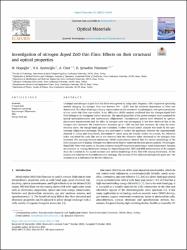| dc.contributor.author | Hopoglu, H | |
| dc.contributor.author | Aydınoglu, H.S. | |
| dc.contributor.author | Ozer, A. | |
| dc.contributor.author | Senadım Tüzemen, E. | |
| dc.date.accessioned | 2022-05-13T11:35:15Z | |
| dc.date.available | 2022-05-13T11:35:15Z | |
| dc.date.issued | (2021) | tr |
| dc.identifier.citation | H. Hopoğlu, H.S. Aydınoğlu, A. Özer, E. Şenadım Tüzemen,
Investigation of nitrogen doped ZnO thin films: Effects on their structural and optical properties,
Optical Materials,
Volume 122, Part A,
2021,
111685,
ISSN 0925-3467, | tr |
| dc.identifier.uri | https://www.sciencedirect.com/science/article/abs/pii/S0925346721008855?via%3Dihub | |
| dc.identifier.uri | https://hdl.handle.net/20.500.12418/13056 | |
| dc.description.abstract | Un-doped and nitrogen-doped ZnO thin films were grown by using radio frequency (RF) magnetron sputtering
method changing the nitrogen flow rate between 0% ����� 12.5% and the thickness dependence of films was
determined. The effect of nitrogen doping concentration on the structural, morphological, and optical properties
of zinc oxide thin films was studied. X-ray diffraction (XRD) analysis confirmed that the nitrogen-doped ZnO
films belong to the hexagonal crystal structure. The optical properties of the grown samples were examined by
optical spectrophotometer and spectroscopic ellipsometer. Transmittance spectra were obtained by spectrophotometer
measurements and the effect of nitrogen ratio was investigated. It has been observed that as the
nitrogen ratio increases, the transmittance decreases up to ~500 nm and then increases. By using the transmittance
curve, the energy band gap was calculated. Further detailed optical analysis was made by the spectroscopic
ellipsometry technique. Fitting was performed to ensure the agreement between the experimentally
obtained Ψ values and theoretically determined Ψ values using the Cauchy model. As a result, the refractive
index was found for each film and it was observed that the refractive index decreased as the nitrogen ratio
increased. The scanning electron microscopy (SEM) measurements showed that the surface morphology of the
films changes with N doping. Nitrogen was observed in Fourier transform infrared spectra analysis. 5% nitrogendoped
ZnO films were grown on the glass substrate using RF magnetron sputtering at room temperature. Samples
are prepared by varying thicknesses during the deposition process. XRD and SEM measurements of the samples
show the variation in the crystal structure and surface morphology of the film with varying thicknesses. All the
samples are tested for the transmittance and band gap. The increase of film thickness increases the grain size. The
transmittance is influenced by the film thickness. | tr |
| dc.language.iso | eng | tr |
| dc.publisher | Elsevier | tr |
| dc.relation.isversionof | 10.1016/j.optmat.2021.111685 | tr |
| dc.rights | info:eu-repo/semantics/openAccess | tr |
| dc.subject | N doped ZnO | tr |
| dc.subject | Magnetron sputtering | tr |
| dc.subject | Spectroscopic Ellipsometer | tr |
| dc.subject | XRD | tr |
| dc.subject | Energy band gap | tr |
| dc.title | Investigation of nitrogen doped ZnO thin films: Effects on their structural and optical properties | tr |
| dc.type | article | tr |
| dc.relation.journal | Optical Materials | tr |
| dc.contributor.department | Mühendislik Fakültesi | tr |
| dc.contributor.authorID | 0000-0002-4207-8207 | tr |
| dc.identifier.volume | 122 | tr |
| dc.identifier.issue | 111685 | tr |
| dc.identifier.endpage | 11 | tr |
| dc.identifier.startpage | 1 | tr |
| dc.relation.publicationcategory | Uluslararası Hakemli Dergide Makale - Kurum Öğretim Elemanı | tr |















